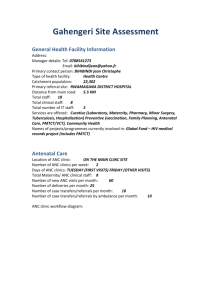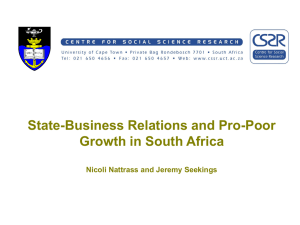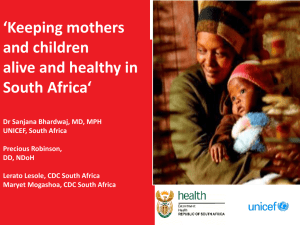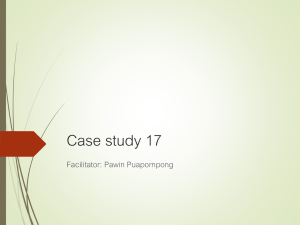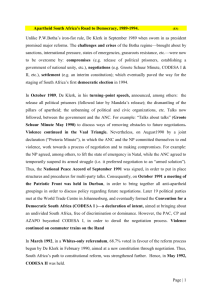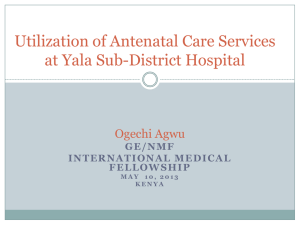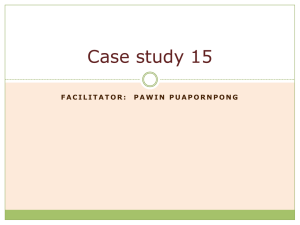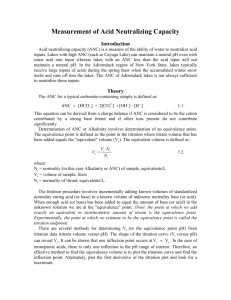Sharma_Sicure
advertisement
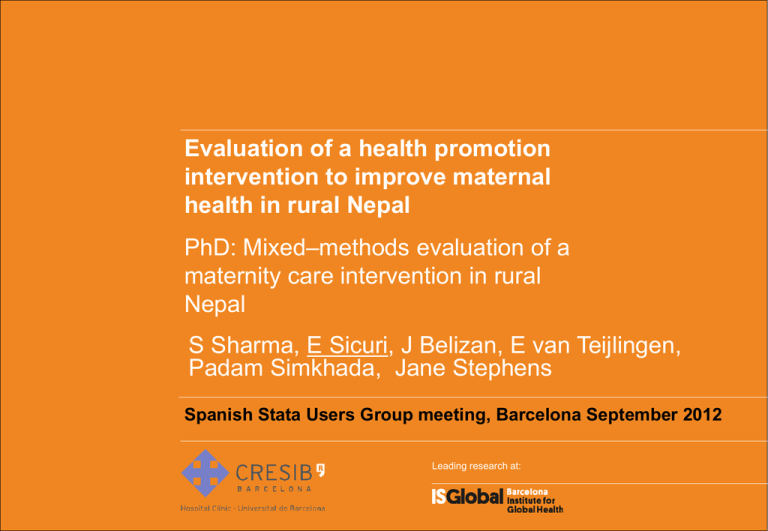
Evaluation of a health promotion intervention to improve maternal health in rural Nepal PhD: Mixed–methods evaluation of a maternity care intervention in rural Nepal S Sharma, E Sicuri, J Belizan, E van Teijlingen, Padam Simkhada, Jane Stephens Spanish Stata Users Group meeting, Barcelona September 2012 Leading research at: Leading research at: Overview of talk • Nepal and intervention background • Maternal and Rural Health Care Issues • Evaluation of the intervention project in Nepal: Methodology Some early findings • Next steps Leading research at: Objective of the PhD To evaluate using mixed-methods: 1. Improved knowledge and increased uptake of reproductive health, antenatal and postnatal care services 2. Improved capacity of community to identify, negotiate and solve health related problems relating to maternal and child health 3. What are the range of barriers to accessing care 4. To determine if the intervention is cost-effective – we first measure the efficacy of the intervention Leading research at: Nepal • Large rural population, majority Hindu (80.6%) • Land-locked between India & China; 240 peaks over 6,096 m • GDP about $1,200 per person per year • Nepal's MMR better than India, Pakistan and Bangladesh with 415 deaths in 2000 to 170 in 2010 per 100,000 live births. Leading research at: Leading research at: Green Tara Nepal (GTN) Health promotion intervention: Improving maternity care in rural Nepal Leading research at: 2007 Green Tara Nepal Intervention 2012 Evaluation (quantitative and qualitative) Leading research at: Health Promotion Cycle Needs assessment Evaluation Health Promotion Cycle Implementation Programme Planning Leading research at: Results of Needs assessment • High burden of preventable disease, most is avoidable through health promotion • Over 70% deliveries take place at home • Lack of knowledge/information • ANC uptake is low, only 28% have 4 visits • Uptake of ANC strongly influenced by socio-cultural factors • The family is very influential: the mother-in-law and daughterin-law relationship influences ANC uptake Leading research at: Health Promotion Groups • Total Participants n=1100 (mostly women aged 15-49; with children less than 2 years old but also Male=56; Mother-in-law=138;Dalit=7) • Groups n=40, covering all villages • 22 mothers-in-law groups • Visited 134 households to support women most in need • Mobile phone given to several groups: - emergency call ambulance - communicate with GTN staff Leading research at: Health Promotion (HP) Groups • The project supported in 64 government’s clinics • 145 warm-baby blankets • Monitoring of Pregnant women and under 2 years Children Leading research at: Before & after study with controls 2006 2007 2008 2010 2012 Preparatory work Control community Intervention community Baseline information Mid-term evaluation Final evaluation I n t e r v e n t i o n Baseline information Mid-term evaluation Final evaluation Leading research at: Study design - controlled before and after - repeated cross-sections - non-randomised study - 833 women of childbearing age (either participating to health promotion activities or not) were interviewed in 4 village development communities included in two surveys in 2008 (baseline) and 2010 (mid-term evaluation) N 2008 2010 INT 208 217 CON 204 204 Leading research at: Control Intervention area Leading research at: Control and Intervention areas selection Visited 6 different communities, two were selected: •Access •Health problems/needs •Political commitment of local leaders •Advice District Public Health office •Distance to Kathmandu + 20 km •No statistically significant differences between individuals in treatment and control groups Leading research at: Demographics of respondents women 15-49, last child<2years of age N=833 (intervention + control) Age at marriage Age at first pregnancy up to 14 years 15-19 years 20-24 years 25-29 years 30 and above years 3% 53.12% 37.75% 5.53% 0.60% 0.84% 40.26% 48.67% 9.03% 0.84% Leading research at: The efficacy of the GTN intervention? In order to ascertain the impact of the intervention: a. we used Difference in Difference approach b. we control for factors such as socioeconomic factors, age, number of children in the household and education Leading research at: Efficacy is determined by the change in ANC uptake due to the intervention • Difference in Difference analysis whereby intervention has had an impact on health uptake behaviour (i.e. ANC visits) i.e. E = (TA-TB) – (CA-CB) Treatment Before (TB) Control Before (CB) Treatment After (TA) Control After (CA) Leading research at: Leading research at: Data base structure for diff-in-diff analysis date treat after treata~r Jan Jan Feb Jan Jan 08 08 08 08 08 1 0 1 0 0 0 0 0 0 0 0 0 0 0 0 Jan Jan Apr Apr Apr 08 08 10 10 10 1 0 1 1 0 0 0 1 1 1 0 0 1 1 0 07 Apr 10 16 Apr 10 08 Apr 10 1 0 1 1 1 1 1 0 1 anc2_5 identify survey idno 66. 88. 196. 314. 371. yes yes no yes yes intervent control intervent control control 1 1 1 1 1 459 66 507 19 14 20 10 04 10 11 391. 395. 418. 421. 533. yes yes yes yes yes intervent control intervent intervent control 1 1 2 2 2 317 137 137 14 278 27 12 11 07 17 574. 623. 810. yes no yes intervent control intervent 2 2 2 19 317 66 Leading research at: PCA: to construct SES variable • We construct a SES based on assets by using Principal Component Analysis PCA, • PCA assets for SES variable were: ownership of household assets (goods such as bicycle, motorcycle, goat, car), type of access to hygienic facilities (sources of drinking water, types of toilet), number of rooms, and construction materials used in the dwelling • Stata: pca dwelling_roof goat1 landgreater3 ownpiped commpiped nonpipedopensource pipedshared flushtoilet pitlatrine othertoiletor_no_t ratioroom_person source_biogas source_lpggas cookersource_elec bicy1_28 mob1_23 friz1_23 com1_23 motorised_veh Leading research at: Definition of efficacy in Difference in difference analysis • To analyse the efficacy of the intervention on different outcomes of health promotion activities • We expect: Measured aspect of health seeking behaviour should improve in the intervention area relative to the control. Non-clinical outcomes chosen ANC uptake: 1. If they attended ANC at least once 2. When? (if during first trimester) 3. How many ANC visits? Results of Diff in Diff ANC attendance at least once Logistic regression N=830 P<0.05 Leading research at: ANC attendance Odds Ratio P 95%Conf Interval Treatment 1.40 0.27 0.76 2.59 After 1.36 0.34 0.73 2.54 after*treatm ent 6.05 0.00 1.98 18.48 SES 2.94 0.00 1.95 4.43 Age 0.90 0.00 0.86 0.94 Education 3.39 0.00 2.09 5.49 N. Of Children 0.77 0.03 0.60 0.98 STATA: logit anc2_5 treat after treatafter SES age1_2 schle1_9 u10_1_13 Results of Diff in Diff – ANC at least once during 1st trimester Logistic regression N=830 P<0.05 Leading research at: ANC in the 1st trimester Odds Ratio P Treat 0.76 0.21 0.49 1.17 After 1.60 0.03 1.04 2.47 after*treatm ent 1.53 0.17 0.83 2.83 SES 2.11 0.00 1.69 2.64 Age 0.98 0.29 0.95 1.01 Education 1.62 0.00 1.34 1.95 N. Of Children 0.76 0.00 0.64 0.89 95%Conf Interval STATA: logit anc2_8btrimester treat after treatafter SES age1_2 schle1_9 u10_1_13 Leading research at: Results of Diff in Diff – How many ANC visits? Poisson regression N= 830 P<0.05 ANC visits Coef. P 95%Conf Interval Treat 0.095 0.05 0.001 0.19 After 0.012 0.81 -0.083 0.11 after*treatme nt 0.12 0.05 -0.007 0.25 SES 0.26 0.00 0.21 0.31 Age -0.02 0.00 -0.024 -0.01 Education 3.39 0.00 2.09 5.50 N. Of Children -0.073 0.00 -0.11 -0.036 Cons 1.29 0.00 1.09 1.50 STATA: poisson anc2_9 treat after treatafter SES age1_2 schle1_9 u10_1_13 Leading research at: Summary of diff in diff analysis and further steps • HP improves the probability of ANC attendance at least once and has a positive impact on the number of visits OR ANC attendance is 6.05 → 6 times more likely to attend ANC Coef. N ANC visits 0.12 (ALTHOUGH BORDERLINE) → women receiving the intervention attended 1.13 times as many ANC visits as women in the control group • But not on going during the 1st trimester : OR ANC in the 1st trimester 1.53 • Can ANC or a combination of maternal health factors be converted in DALYs, i.e. maternal deaths averted by ANC attendance? How can we translate ANC attendance into health outcome? Leading research at: Further analysis of intervention • Overall effect → (Direct + Indirect) All women a) Direct Effect → Women who attend GTN groups b) Indirect (herd) Effect → Women who did not •Efficacy → Health Effectiveness 1) The Cost Efficacy Ratio where intervention costs are divided by increased probability of ANC attendance. Can efficacy be translated into DALYs averted due to intervention? 2) Cost-efficacy → Costs effectiveness GRÀCIES! Leading research at:


